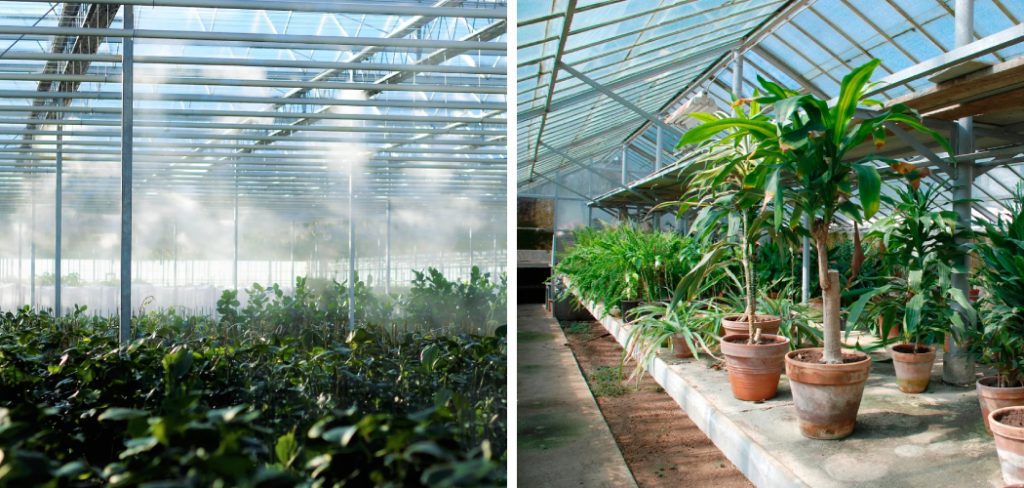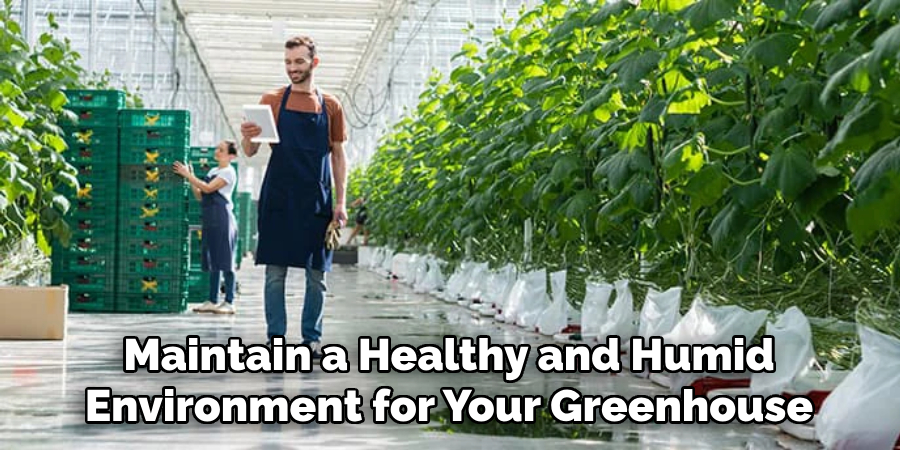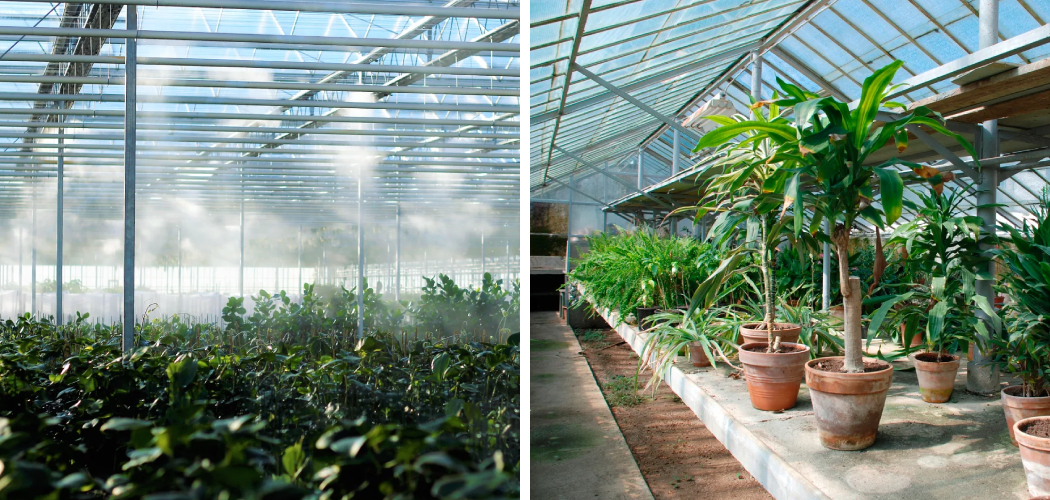To add humidity to a greenhouse, you can use methods like misting the plants or employing a humidifier. Adding moisture to the air in a greenhouse helps create the ideal growing conditions for plants.
Greenhouses provide a controlled environment for plants to thrive, but the humidity levels inside can sometimes be too low. Low humidity can lead to problems like wilting, dry soil, and even plant diseases. To avoid these issues, it’s essential to maintain adequate humidity levels in your greenhouse.
Fortunately, there are several effective ways to add humidity to a greenhouse. One method is misting the plants regularly with water. This increases moisture in the air and helps to prevent dryness. Another option is using a humidifier, which releases water vapor into the greenhouse to raise humidity levels. By employing these methods, you can create a suitable and healthy environment for your plants to grow and prosper in your greenhouse.

Importance Of Humidity In A Greenhouse
Maintaining optimal humidity levels is crucial for the success of a greenhouse. Understanding the role of humidity in plant growth is the first step towards creating a suitable environment. Humidity directly affects transpiration, which is the process of water absorption and nutrient uptake in plants.
By providing the right amount of moisture in the air, you can ensure that plants receive adequate hydration. This improves their overall health, growth, and productivity. Additionally, humidity helps regulate temperature variations and prevents excessive water loss through evaporation. It also reduces the chances of pests and diseases by creating an environment unfavorable for their growth.
So, by monitoring and adjusting humidity levels in your greenhouse, you can maximize the benefits for your plants and create an ideal growing environment for them.
How to Add Humidity to a Greenhouse: Effective Methods
Natural Methods To Increase Humidity
When it comes to adding humidity to a greenhouse, natural methods are highly effective. One such method is using water features to increase humidity. By strategically placing water features like fountains or ponds in the greenhouse, the evaporation of water can create a humid microclimate.
Additionally, incorporating plants that have high transpiration rates can also help increase humidity levels. These plants release moisture into the air through their leaves, contributing to a more humid environment. Another option is implementing a misting system, which allows for controlled humidity levels.
This system disperses water droplets throughout the greenhouse, maintaining optimal moisture levels for the plants. By using these natural methods, greenhouse owners can easily and efficiently increase humidity without relying on artificial means.
Artificial Methods To Increase Humidity
Increasing humidity in a greenhouse can be achieved through various artificial methods. One effective approach is installing a humidifier, which releases moisture into the air. Another option is utilizing fogging systems that efficiently regulate humidity levels. Additionally, using evaporative coolers is an effective way to add moisture to the air.
These coolers draw in warm air and pass it through water-soaked pads, resulting in increased humidity. By implementing these methods, greenhouse owners can create an optimal growing environment for their plants. Proper humidity levels can help to prevent plant stress, improve growth, and maintain optimal conditions essential for successful plant cultivation.
Monitoring And Maintaining Humidity Levels
Maintaining humidity levels in a greenhouse is crucial for successful plant growth. Accurate measurement of humidity is important to ensure optimal conditions. Various tools and devices are available for monitoring humidity, allowing growers to make informed decisions. From hygrometers to dataloggers, these instruments provide real-time data for effective control.
Adjusting and maintaining the desired humidity levels requires implementing different techniques. For example, using misting systems or employing evaporative cooling can increase humidity. On the other hand, ventilation and dehumidification techniques help reduce humidity when necessary. It is essential to find the right balance to create the ideal environment for plants.
By carefully monitoring and adjusting humidity levels, greenhouse growers can promote healthier and more vigorous plant growth.
Considerations For Humidity Management
Maintaining optimal humidity levels in a greenhouse is crucial for successful plant growth. To manage humidity effectively, it is important to consider the specific needs of different plant species. Identify the ideal humidity range for each type of plant to ensure healthy growth.
Excessive humidity can lead to a range of problems, including diseases and fungal infections. To prevent these risks, proper ventilation is essential. Use fans, vents, and open windows to ensure adequate air circulation, which will help regulate humidity levels. Additionally, it is advisable to avoid overwatering and to use well-draining soil to prevent water accumulation.
By following these considerations for humidity management, you can create an ideal environment for your plants to thrive in the greenhouse.
Best Plants For Naturally Increasing Humidity
Plants with high transpiration rates are excellent for naturally increasing humidity levels in a greenhouse. These plant species release moisture into the air, helping to create the desired humidity. By utilizing plants known for their transpiration abilities, you can easily maintain a healthy and humid environment for your greenhouse.

These plants act as natural humidifiers, reducing the need for artificial methods to increase humidity. With their natural ability to release moisture, they provide an effective and eco-friendly solution. Choose plants such as ferns, peace lilies, spider plants, and boston ivy, as they are known for their high transpiration rates.
By incorporating these plants into your greenhouse, you can easily add humidity and create the ideal environment for your plants’ growth and well-being.
Frequently Asked Questions Of How To Add Humidity To A Greenhouse
How Do I Increase Humidity In My Greenhouse In The Winter?
During the winter months, when the air tends to be drier, there are several ways to increase humidity in your greenhouse. Consider strategies such as watering the floor, using misting systems, placing trays of water around the greenhouse, or installing a humidifier.
What Is The Optimal Humidity Level For A Greenhouse?
The ideal humidity level for a greenhouse varies depending on the plants you are growing. In general, a humidity range of 50% to 70% is recommended. It is important to monitor and adjust the humidity levels based on the specific needs of your plants.
Can I Use A Humidifier To Add Humidity To A Greenhouse?
Yes, a humidifier can be an effective way to add moisture to a greenhouse. Choose a humidifier that is suitable for the size of your greenhouse and consider using one with adjustable settings to maintain the desired humidity level.
Should I Mist My Plants To Increase Humidity In The Greenhouse?
Misting your plants can be a helpful method to increase humidity in a greenhouse. However, it is important to avoid over-misting, as excessive moisture can lead to issues like mold and disease. Find the right balance and mist the plants sparingly to provide a humidity boost.
How Often Should I Water The Floors Of My Greenhouse To Increase Humidity?
Watering the floors of your greenhouse is a useful technique to increase humidity. The frequency will depend on factors such as the temperature and humidity levels in your greenhouse. Monitor the moisture levels and water the floors as needed to maintain the desired humidity.
Conclusion
Maintaining the right level of humidity in your greenhouse is crucial for the health and growth of your plants. By implementing the methods mentioned above, such as misting, using water trays, and evaporative coolers, you can effectively add humidity to your greenhouse.
Additionally, utilizing a humidistat will help you monitor and control the humidity levels precisely. Remember to consider the specific needs of your plants and adjust accordingly. Whether you are growing delicate orchids or thriving vegetables, providing adequate humidity will promote optimal growth and reduce the risk of plants drying out or succumbing to common pests and diseases.
So, go ahead and experiment with different techniques, find what works best for your greenhouse, and enjoy the lush, vibrant environment that your plants will thrive in.

